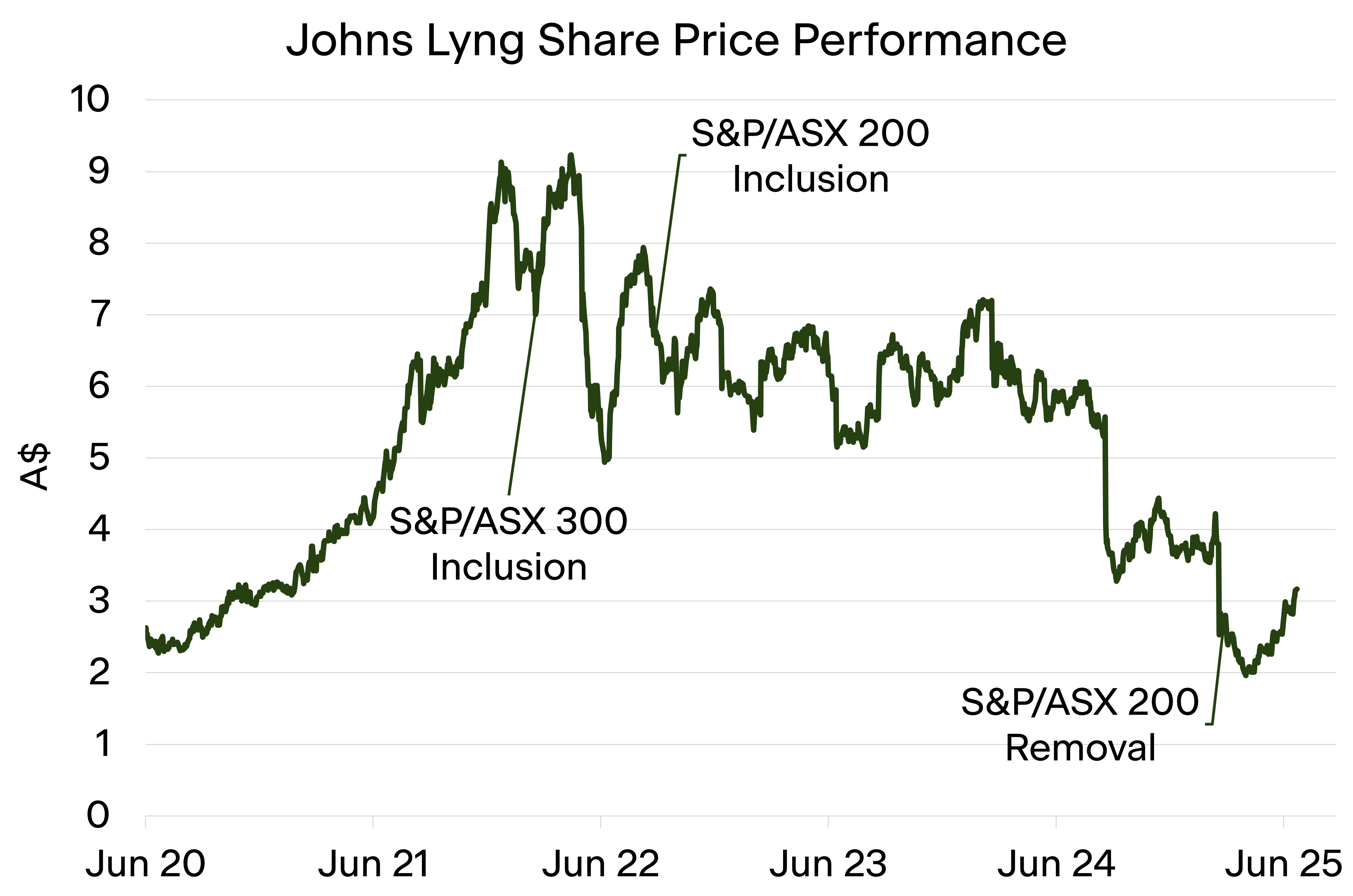The passive giants are leaving crumbs - and we’re feasting
Investing in small caps can sometimes feel like living in the shadow of a giant. But as giants lumber across the market, they drop crumbs — and for nimble investors like us, those crumbs can be a feast.
The rise of passive funds and superannuation behemoths has reshaped equity markets. It’s a trend that’s largely good for investors: lower fees, broad diversification, and disciplined investing. But it also creates distortions, especially in smaller companies, and that’s where our opportunities lie.
Here’s how passive investing trends have delivered three key tailwinds for us over the past year.
1. Price-agnostic sellers
First, passive giants often become forced sellers when companies slip out of the indices they track. Stocks that were once big enough to be in the S&P/ASX 200 or 300 can suddenly find themselves dropped — and their share prices can collapse under waves of indiscriminate selling.
Take Johns Lyng (ASX: JLG). Its market cap topped $2 billion in 2022, earning it a spot in the S&P/ASX 200. But by March this year, it had fallen more than 75% from its peak and was booted from the index. While the business may not be quite as good as markets once believed, we don’t think it’s nearly as bad as the share price suggests. Yet much of the share price plunge reflects passive selling from investors who never even asked the question: what’s this business worth?
.png)
Fund closures have also played a role. Several small-cap managers closed shop over the past year as super funds pulled mandates, flooding the market with stocks that had to be sold regardless of price. That’s when we step in: to pick up quality businesses at fire-sale prices.
2. Thematic waves
Second, the boom in thematic ETFs is creating new pockets of opportunity. Thematic funds let investors bet on trends like defence, artificial intelligence, or cybersecurity. But while they promise targeted exposure, they often carry high fees and can attract hot money that rushes in at the top, and then flees at the bottom.
We’ve seen some great businesses get tossed out with the thematic bathwater. Comfort Systems (NYSE: FIX), a US-based HVAC specialist, is a perfect example. We first met management in 2023 and thought it was a solid business, but probably too expensive. A year later, our International Fund’s Harvey Migotti revisited the company and flagged significant tailwinds from data centre construction and reshoring US manufacturing.
The stock had doubled in the interim. But then came Donald Trump’s renewed assault on global trade, and Comfort Systems’ share price fell 46% in just over two months. Fundamentally, nothing had changed: the company had net cash and years of work ahead. Yet thematic outflows crushed its price, giving us an excellent buying window. That kind of volatility is music to our ears.
3. Crumbs that grow large enough for giants
Third, some crumbs eventually become big enough for giants to notice. It is at this stage that passive buying can turbocharge returns.
Look at Catapult Group (ASX: CAT). In May 2022, the stock typically traded between $100,000 and $200,000 per day. Now, with Catapult firmly included in the S&P/ASX 300, it’s rare for daily volumes to fall below one million shares. With the share price up fivefold, that equates to more than $5 million worth of shares traded daily—and $10 million days are not uncommon.
Index inclusion hasn’t been the whole story. Catapult’s business has genuinely improved, with revenue growing nearly 20% a year. But being added to the S&P/ASX 300 has poured fuel on the fire, forcing passive funds to buy in and adding liquidity and visibility.
That’s why, when we’re evaluating new investments, we always ask: Could this business eventually attract passive buying? It’s not the only reason to own a stock, but it can dramatically amplify returns once the giants start paying attention.
Passive giants will keep dominating markets. And yes, small-cap indices have lagged their large-cap counterparts in recent years. But that doesn’t mean all small-cap investing is doomed. Some active managers — including us at Forager — have delivered excellent returns by hunting among the crumbs: forced sellers, battered thematic plays, and future index entrants.
As the passive influence continues to grow, those crumbs should keep falling. And for nimble investors, they’re a feast worth pursuing.
This is an excerpt from Forager’s Annual Report which is due to be released in the coming days. Subscribe to our monthly and quarterly reports here to receive the annual report directly to your inbox.
3 stocks mentioned
.jpg)
.jpg)